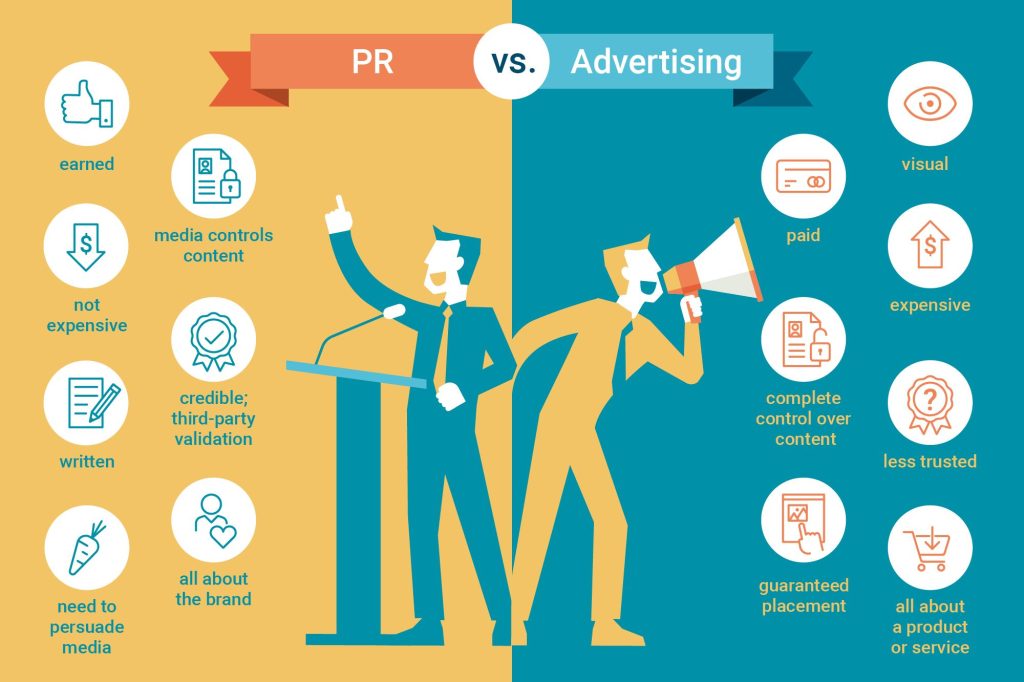Marketing and PR are two key concepts in modern business culture. Every day, we encounter various advertising and marketing campaigns, as well as news reports that create a certain opinion about an organization or product. But what do these terms actually mean, and how did they appear in history?
Two concepts
Marketing is the process of planning and implementing concepts, products, prices, promotion and distribution of an idea, goods or services that satisfy consumer needs and achieve the organization's goals. Marketing is an integral part of any business and includes many elements such as market research, brand management, competitor analysis, target audience determination, etc.
The term “marketing” was coined in the mid-20th century, although the concept of marketing has been around since the Industrial Revolution in the 18th century. The basic idea of marketing is that companies should research the needs and wants of consumers and create products or services that satisfy these needs. In the past, companies believed that their products would be in demand without the need for any special advertising. However, in the 20th century, marketing became an important tool for promoting products and services in the market.
PR (Public Relations) is the process of creating and managing the public image of a company or organization. PR includes a wide range of activities, such as creating press releases, organizing events, communicating with journalists and bloggers, creating web content, etc.
Target PR is about establishing good relations with the public and creating a positive perception of a company or organization.
The term “PR” emerged in the early 20th century when companies began to realize that their public image was important and could impact the success of their business. In 1906, Ivy Lee is considered one of the first people to use the term “Public Relations” in their work. He was hired by a railroad company in the United States that was facing a major disaster and Ivy Lee was hired to manage public relations and change people’s perceptions of the company.
In the 1920s, PR began to be used more and more frequently by large companies such as General Electric, Procter & Gamble, and AT&T. In the 1950s and 1960s, PR became an indispensable tool in political campaigns, and many political leaders began to use PR techniques to create their image and communicate with voters.
Today, marketing and PR are an integral part of any company or organization, and their use has become essential for creating a successful business and managing public image. In the modern world, there are many methods and technologies that help companies achieve their marketing and PR goals, and these areas continue to evolve and change in line with changes in society and technological innovations.


Differences between Marketing and PR
Маркетинг и PR — два важных аспекта бизнеса, которые помогают организациям достигать успеха в своей отрасли. Они оба имеют дело с коммуникациями и созданием стратегий, но имеют некоторые ключевые различия.
Одно из главных отличий между маркетингом и PR заключается в том, что маркетинг — это способ продвижения товаров и услуг, которые компания предлагает на рынке, а PR — это способ управления общественным мнением о компании. Маркетинг обычно включает в себя исследования рынка, позиционирование бренда, рекламу и продажи, а PR — это отношения с общественностью, связи с общественностью, управление репутацией и кризисное управление.
Target audience:
Marketing and PR have different target audiences. Marketing is usually aimed at a target audience that is already interested in the product or service. This means that marketing strategies can be more focused and sales-oriented, since the customer is already considering the product.
On the other hand, PR is focused on a broad audience and the overall reputation of the brand. It is not sales-oriented, but rather on creating a respected image of the company in the eyes of a broad audience, which in turn can lead to potential sales.
Tactics: Goals and Focus:
Marketing and PR also have different goals and focuses. Marketing aims to increase sales and profits for the company. It focuses on the specific products and services the company offers and how best to sell them.
PR has a broader focus and aims to create a positive brand image and strengthen public relations. It may include media outreach, creating content for social media, and other forms of public communication.
Money
Finally, marketing and PR have different budgets and expenses. Marketing often requires a large investment, as it is aimed at attracting new customers and increasing sales. A large part of the marketing budget can be spent on advertising, events, and product promotion.
PR, on the other hand, can be a more cost-effective option, as it focuses on building a company's image and public relations. A PR budget may include paying a PR agency, organizing press conferences, working with social media, and creating content. However, a more successful PR campaign may require more time and effort to create and maintain public relations.
Degree of trust
Еще одним отличием между маркетингом и PR является степень доверия. В маркетинге компания часто выступает в роли продавца, а потенциальный клиент — в роли покупателя. Поэтому многие люди относятся к маркетингу с определенной долей недоверия и скептицизма. С другой стороны, PR часто связан с управлением репутацией компании, общественной деятельностью и коммуникацией с заинтересованными сторонами. В этом случае отношения с общественностью могут повышать доверие и создавать положительный образ компании.

Form of communication
Another difference between marketing and PR is the form of communication. Marketing often uses a one-way channel of interaction, where a company promotes its products or services, and customers either accept the offer or not. At the same time, PR usually uses a two-way channel of interaction, where a company creates a dialogue with the public, listens to their opinions, and responds to them.
Evaluation of results
Finally, marketing and PR differ in how results are measured and evaluated. In marketing, results are usually evaluated in terms of sales, conversions, and other metrics that can be measured and compared to other companies.
In PR, on the other hand, the results are often more difficult to measure and evaluate. For example, public opinion about a company or its reputation can be perceived and subjective. However, there are tools to evaluate these indicators, such as social media monitoring, public opinion polls, reputation analysis, and others.
Маркетинг и PR — это две различные, но взаимосвязанные функции, которые помогают компаниям достичь своих бизнес-целей. Обе эти функции ориентированы на взаимодействие с аудиторией, но имеют различные цели и методы.
Маркетинг — это процесс планирования и реализации действий, направленных на продвижение продуктов и услуг компании на рынок. Главной целью маркетинга является увеличение продаж и доходов компании. Для достижения этой цели маркетинг использует широкий спектр инструментов, включая рекламу, продвижение в социальных сетях, SEO-оптимизацию, управление ценами, исследования рынка и т.д.
PR (public relations) — это процесс создания и поддержания положительного имиджа компании в глазах ее аудитории. Главной целью PR является установление и поддержание доверительных отношений с потребителями, инвесторами, СМИ и другими заинтересованными сторонами. Для достижения этой цели PR использует различные инструменты, включая организацию пресс-конференций, участие в общественных мероприятиях, публикацию статей в СМИ, мониторинг репутации и т.д.
Life cycle and impact on the product
Marketing is sales-oriented and is usually associated with specific promotional campaigns that have a defined life cycle. PR, on the other hand, is focused on long-term relationships with the audience and its life cycle has no clear boundaries.
One of the key aspects that distinguishes these two areas is their impact on the product life cycle.
The product life cycle is the process of product development from its creation to its exit from the market. This cycle consists of several stages, including development, introduction, growth, maturity and decline. Each of these stages has its own unique characteristics and requires a specific approach from marketing and PR.
During the product development stage, marketing and PR play an important role in identifying market needs and assessing the competitive environment. Marketing can conduct market research and determine which consumers are interested in the product, and PR can determine which media will be most effective in promoting the product.
At the introduction stage, marketing plays a key role in promoting the product in the market. Marketing may develop a product promotion strategy, including pricing, placement, and promotion of the product. PR may focus on establishing a positive image of the company and the product, using the media to disseminate information about the product.
In the growth stage, marketing and PR can work together to continue to attract new customers and develop the brand. Marketing can develop a strategy to expand the market, and PR can use the media to strengthen the company and product image.
At the maturity stage, marketing and PR can focus on maintaining and increasing market share. Marketing can continue to research the market and develop new promotion strategies, and PR can continue to strengthen the company and product image.
In the decline stage, marketing and PR can work together to manage the product life cycle and minimize losses. Marketing can develop a strategy to reduce costs and cut sales, and PR can use the media to reduce the negative impact on the company and product image.
One of the main differences between marketing and PR is their primary purpose. Marketing focuses on selling a product, while PR focuses on creating and maintaining a positive image of a company. Marketing may use advertising, direct sales, and other methods to convince consumers to buy a product, while PR may use public relations, social media, and other means to create a positive image of a company.
Another difference between marketing and PR is their approach to communicating with consumers. Marketing usually works directly with consumers, providing them with information about a product and convincing them to buy it. PR works through the media to create a positive image of the company and product in the eyes of consumers.

Conclusion
Ultimately, marketing and PR are two important components of a product’s marketing strategy. Although the two areas are closely related, each has its own unique characteristics and requires different approaches to manage the product life cycle. It is important to note that marketing and PR are interrelated and can reinforce each other. Marketing can help increase brand awareness and attract new customers, while PR can strengthen relationships with existing customers and increase audience loyalty.
However, despite the similarities and interrelationships, marketing and PR still have their differences and different methods of work. When used correctly, both functions can help a company achieve its business goals and establish long-term relationships with its audience.








